Children of Men Analysis
It’s a
dystopian-based science fiction film that is set in the year 2027. The opening
credits are first show; the production company was introduced in this case it
was Universal Studios. There were no non-diegetic sounds in the scene. This is
done to capture the audience’s attention. There’s then a black screen with a
sound bridge this makes the audience listen carefully to the dialogue. The
names of the production companies are repeated, this is done so that the
audience remember who the makers of the film are because if they like the film
they will be encouraged to watch other films made by the same company. The next
scene is of a café you know this because of the wallpaper, the coffee mugs in
people’s hands and sandwich bars. It’s a social hotspot where people meet and
interact. Everyone in the café is old; this relates to the narrative that women
are now infertile so they can’t have children. The main character walks in, you
know this because he is the only mobile person in the scene and the camera
focuses on him everyone else is still and focused on what’s on TV. When he
walks out of the café the camera follows him, and pans around. This is done to
introduce the audience to a new setting. The year and place is also shown to
ease the audiences understanding of the situation. The camera then continues to
follow him and circles around him, to make you feel like you’re around the
character. The lighting is dark/grey/muted which connotes sadness and
depression. The sparse amount of light connotes there’s no hope for the future
and bleakness. The narrative is introduced in the first few seconds of the
opening sequence. It establishes the current situation and informs the
audience.





